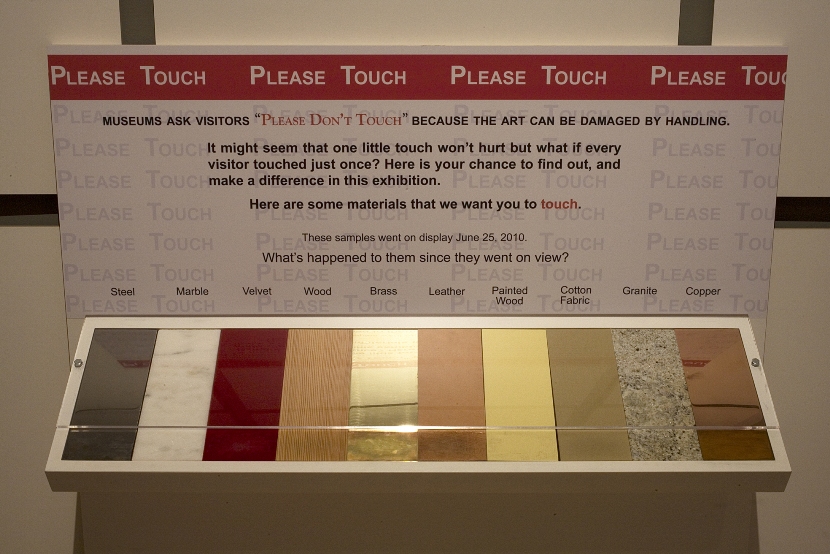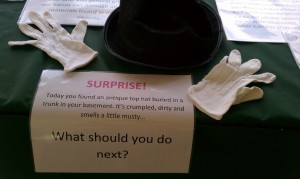The Question:
Bronwyn Eve, Project Manager, Illinois Connecting to Collections wrote in asking:
The Illinois State Museum is hosting a tent at the Illinois State Fair. I’d like to have a display promoting preservation of collections. Anyone have any ideas for a hands-on project that they would recommend?
Here are some ideas:
From Adrienne Berney, Collections Care Trainer, DCR Connecting to Collections, Raleigh, NC:
One project we’re working on here in North Carolina that might be good for a state fair is getting museums to install a “touch panel” of different materials, similar to one that Colonial Williamsburg developed for its “Conservation: Where Art and Science Meet” exhibit. A row of plexi covered about 3/4 of the materials on CW’s touch board. Visitors were encouraged to touch the unprotected section of the materials and over time, they could see how the touched materials compared to the protected section.
 Here is a photo of the exhibit courtesy of Emily Williams, a conservator at Colonial Williamsburg. In North Carolina, they are adapting the idea on a smaller, less expensive scale.
Here is a photo of the exhibit courtesy of Emily Williams, a conservator at Colonial Williamsburg. In North Carolina, they are adapting the idea on a smaller, less expensive scale.
From Kristen Laise, Vice President, Collections Care Programs, Heritage Preservation:
What about showing people how to store their family artifacts? Such as how to fold an heirloom quilt and pad it with tissue (using a non-heirloom quilt of course), the proper boxes in which store a family bible, etc.
From M.J. Davis, Conservator in Private Practice in Vermont:
I did this type of thing for several years at the Vermont History Expo and just as you suggested had a quilt box and tissue to demo quilt storage, family photos was a big topic so I had stuff from Gaylord Brothers and University Products as samples (many archival supply companies are happy to send out samples). Paintings was the other bigger topic I was asked about so I always had my American Institute for Conservation directory with me to give paintings conservators names out. [M.J. developed a handy list of preservation resources that may be downloaded here.]
From Moira Egan, Executive Vice President, Heritage Preservation:
Maybe something on how to safely store/display the “treasured” stuffed animals they are sure to be winning at the fair?
From Nancie Ravenel, Objects Conservator, Shelburne Museum, Shelburne, VT:
Carolyn Frisa, Emily Gardiner, and Laura Brill had a great display at the last History Expo in Tunbridge, VT. Carolyn brought a late 19th c. crazy quilt from her own collection (and she made it very clear that it was from her own collection, not the museum’s collection). She talked about how to handle something so fragile as well as how to store it appropriately. That was a huge hit in part because she was connected to the object and because the audience at the expo was folks involved with historic houses, historical societies, and re-enactor groups. Carolyn had catalogs from a variety of archival supply vendors on hand and I think she had IMLS and Heritage Preservation documents too. [Note: if you need any Heritage Preservation or IMLS materials like these, feel free to contact us and we can help you out!]
Another idea from Nancie:
Demonstrate proper matting and framing. For truly hands on, though it would cost some money, maybe folks could make a quilt square, a drawing, or a photo (using a digital camera and portable printer) of themselves at the Fair and then make an enclosure for their new “treasure”? Or demonstrate how to care for photo albums and how to scan old family photographs along with a handout with guidelines that they could take home.
From Sara Gonzales, Conservation Assessment Program Coordinator, Heritage Preservation:
Do simple cleaning demonstrations with inexpensive, easy-to-find cleaners to teach people how to clean their silver, etc., the right way. The American Institute for Conservation’s Caring for Your Treasures leaflets might be a great handouts to provide.
From Lauren Hunley, Program Associate for Membership and Management:
A cleaning or deterioration activity would be cool… something small like working with corroded pennies or some other science experiment activity that would appeal to both kids and adults. The Save Outdoor Sculpture “Inside Outdoor Sculpture” book and kit has great ideas such as:
1. Take 2 different colors of construction paper, and cut a fair sized hole in one and staple/tape it on top of the 2nd. Hang it out in the sun throughout the week and track how faded the paper gets to illustrate the fading affects of light on an object.
2. Fill a clear cup with about an inch of water, and add several drops of food coloring. Place different materials (chalk, celery, paper towel) in the water for about 15-20 minutes. Observing how the materials absorb water illustrates the need for good HVAC in a facility and visually enforces why food and water should not be handled/stored around objects.
Bronwyn Eve sent us some photos from the state fair:






